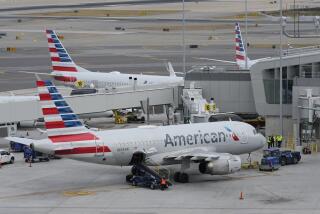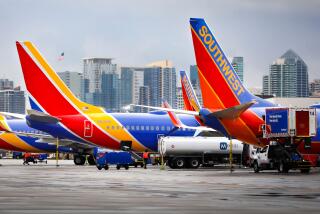Airfares drop while airlines score big profits

The average domestic airfare this fall is forecast to be $248, or 3.6% cheaper than in fall 2014. Above, travelers at Chicago O’Hare International Airport.
If you plan to travel this fall, expect to pay the lowest airfares in years.
The average domestic airfare for the September-through-November period is forecast to be $248, or 3.6% cheaper than in fall 2014 and 8.1% cheaper than in the same three months of 2013, according to the Boston flight research site Hopper.com.
Domestic fares for flights out of Los Angeles International Airport should be even lower for the same period, dropping about 9.4% compared with last year, according to Hopper.com.
That’s sounds like great news until you dig deeper into the numbers.
One of the key reasons the nation’s airlines can keep domestic fares low is that the industry’s biggest expense — fuel — has dropped about 30% over the last year. Given that, airline critics say the decline in fares should be even bigger.
“The fares haven’t dropped much given how dramatically fuel prices have dropped,” said Tyler Hanson, the data scientist for Hopper.com who crunched airfares for the study. “They are not passing everything on to consumers. They are keeping some for profit.”
Thanks to the drop in fuel costs, Southwest, United, Alaska, Delta and American airlines all reported record-high profits in the three-month period that ended in June.
Another reason airlines can keep fares low is that they are generating more of their overall revenue from fees for checked bags, reservation changes, food, entertainment and seat upgrades, among other charges.
In the first quarter, the nation’s largest carriers collected $863 million in bag fees, a 9% increase over the same period in 2014, and $768 million in reservation change fees, a 6% increase, according to the U.S. Department of Transportation.
Also contributing to the fare drop, Hanson said, is the expansion of low-cost carriers that offer rock-bottom prices along with cramped seats and passenger fees for a growing list of services.
For example, ultra-low-cost carrier Spirit Airlines recently announced new nonstop flights from LAX to Kansas City and Baltimore. But the Florida-based carrier also announced a $2 increase in bag fees for the busy summer period.
Airfares should start to creep back up again once demand increases for the holiday travel season, Hanson said, bringing overall fares for the year on par with last year’s prices.
Meanwhile, airline executives are predicting hefty profits for the rest of the year — as long as fuel prices remain stable.
To read more about travel, tourism and the airline industry, follow me on Twitter at @hugomartin.







